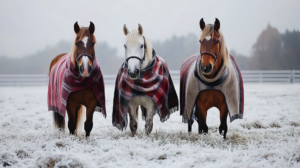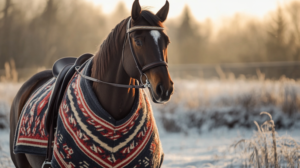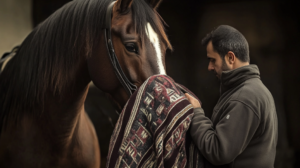Horse blankets, essential gear for equestrians, have a rich history that mirrors the evolution of human civilization and the development of our relationship with horses. From humble beginnings to modern, high-tech designs, horse blankets have undergone significant changes, reflecting advancements in materials, technology, and our understanding of horse care.
In my opinion, the evolution of horse blankets is a fascinating reflection of both technological advancements and our deepening understanding of equine welfare. The journey from rudimentary coverings to the sophisticated, high-tech blankets of today showcases our progress in textile technology and our growing commitment to the comfort and well-being of our equine partners. This blog post will take you on a journey through the history and evolution of horse blankets, exploring how they have transformed over the centuries.
Early Beginnings: The Primitive Era
In ancient times, horse blankets were simple and utilitarian, made from readily available materials such as animal hides, wool, and even woven plant fibers. Early horse blankets were designed primarily to provide warmth and protection from the elements. Ancient civilizations, including the Greeks and Romans, used basic coverings to shield their horses from cold weather and harsh environmental conditions. These early blankets were often crudely stitched and lacked the refined design seen in later periods.
The Middle Ages: Functional Design
During the Middle Ages, horse blankets became more sophisticated as craftsmanship improved and the needs of mounted warriors and knights became more pronounced. The medieval horse blanket, often called a “caparison,” was elaborately decorated for protection and as a symbol of status and wealth. These blankets were made from high-quality fabrics like wool and sometimes adorned with intricate embroidery and heraldic designs. They provided insulation and protection during long rides and harsh weather conditions.
The Renaissance to the 18th Century: Innovation and Style
The Renaissance period saw further advancements in the design and production of horse blankets. With the rise of trade and exploration, new materials such as silk and velvet became available, allowing for more luxurious and ornate blankets. The 18th century brought about even more innovations, including padded and quilted blankets, which offered improved comfort and protection. These advancements were driven by both practical needs and the desire for aesthetic appeal as horse blankets began to reflect the status of their owners.
The 19th Century: Industrial Revolution and Mass Production
The Industrial Revolution marked a significant turning point in the history of horse blankets. With the advent of mechanized weaving and advancements in textile technology, horse blankets became more widely available and affordable. Manufacturers began producing blankets from durable, synthetic fabrics such as cotton and polyester, which offered better performance and easier maintenance than traditional materials. The 19th century also saw the introduction of specialized blankets designed for specific purposes, such as cooling blankets, exercise sheets, and stable blankets.
The 20th Century: Technological Advances and Specialization
The 20th century brought about a host of technological advancements that revolutionized the design and functionality of horse blankets. Developing high-tech synthetic materials such as fleece, waterproof membranes, and breathable fabrics allowed greater versatility and performance. Horse blankets became more specialized, with options for different weather conditions, activities, and specific needs. Innovations like adjustable straps, ergonomic designs, and easy-to-use fastenings made horse blankets more user-friendly and effective.
The 21st Century: High-Tech Materials and Customization
Today, horse blankets are at the forefront of textile technology and customization. Modern horse blankets are crafted from cutting-edge materials such as breathable membranes, moisture-wicking fabrics, and advanced insulation technologies. Customization options allow horse owners to select blankets tailored to their horses’ needs, including fit, size, and features. Additionally, advancements in design and manufacturing have made horse blankets more aesthetically pleasing, with a wide range of colors, patterns, and styles available.
Reflecting on the evolution of horse blankets, it’s clear that these garments have transcended their original function to become a blend of technology, comfort, and style. As someone deeply immersed in equestrian care, I’m continually impressed by how innovations in horse blankets enhance our ability to keep horses comfortable and healthy. The journey from primitive coverings to today’s advanced designs underscores our progress in material science and our growing commitment to the well-being of our equine partners.





